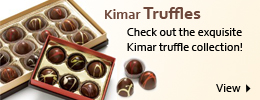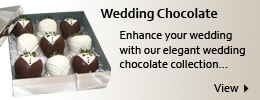History of Chocolate
| 600 | Culture and Cocoa |
|
A.D. 600 the Mayas undertook a massive migration which led this highly civilised
people from Central America deep into the northern regions of South America. In
Yucatan they established the earliest known cocoa plantations. There is no doubt,
however, that the Mayas must have been familiar with cocoa several centuries earlier.
|
|
| 1000 | Beans and Figures |
|
From the very early days of cocoa the peoples of Central America used beans as a
form of payment. The use of cocoa beans as units of calculation must also have become
established before A.D. 1000. One Zontli equalled 400 cocoa beans, while 8000 beans
equalled one Xiquipilli. In Mexican picture scripts a basket with 8000 beans represents
the figure 8000.
|
|
| 1200 | Chocolate War |
|
By subjugating the Chimimeken and the Mayas, the Aztecs strengthened their supremacy
in Mexico. Records dating from this period include details of deliveries of cocoa
which were imposed as tributes on conquered tribes.
|
|
| 1502 | Columbus and the Cocoa bean |
|
On his fourth voyage to America, Columbus landed on 30th July 1502 in Nicaragua
and was the first European to discover cocoa beans. These were used by the natives
as currency and also in the preparation of a delightful drink. But Columbus, who
was still searching for the sea route to India, was not interested in cocoa.
|
|
| 1513 | Payment in Beans |
|
Hernando de Oviedo y Valdez, who went to America in 1513 as a member of Pedrarias
Avila's expedition, reports that he bought a slave for 100 cocoa beans.
|
|
| 1519 | A Spanish Bank |
|
Hernando Cortez, who conquered part of Mexico in 1519, finds the taste of cocoa
not particularly pleasant and is, therefore, much more interested in the value of
cocoa as a means of payment. He immediately establishes in the name of Spain a cocoa
plantation where, henceforth, 'money' will be cultivated.
|
|
| 1528 | Sweet Plunder |
|
In 1528, Cortez brings back to Europe the first cocoa and the utensils necessary
for its preparation.
|
|
| 1609 | The First Chocology |
|
'Libro en el cual se trata del chocolate' is the title of a book which appear- ed
in Mexico in 1609. It is the first book devoted entirely to the subject of chocolate.
|
|
| 1615 | Fruitful Marriage |
|
The Spanish princess Anna of Austria marries Louis XIII and intro- duces, amongst
other Spanish customs, the drinking of chocolate at the French court.
|
|
| 1657 | A Frenchman in London |
|
London's first chocolate shop is opened by a Frenchman in 1657.
|
|
| 1662 | A Solomon of Chocolate |
|
After Pope Pius V had found cocoa so unpleasant that he declared, in 1569, that
"this drink does not break the fast", the supreme church of Rome became more and
more tolerant towards the exquisite beverage. The question of the fast took on a
new urgency. In 1662, Cardinal Brancaccio hands down the judgment of Solomon:"Liquidum
non fragit jejunum." In other words:"Liquids (in the form of chocolate) do not break
the fast." Clearly, one had to wait until Easter to indulge in the eating of chocolate.
|
|
| 1670 | The Fate of a Seaman |
|
Helmsman Pedro Bravo do los Camerinos decides that he has had enough of Christian
voyages of exploration and settles in the Philippines, where he spends the rest
of his life planting cocoa, thus laying the foundations for one of the great plantations
of that time.
|
|
| 1671 | Blissful Accident |
|
A clumsy kitchen-boy drops a bowlful of almonds on the floor. The angry chef tries
to box his ears and, in the process, spills a panful of hot, burnt sugar over the
almonds. The Duke of Plesslis-Praslin, a marshal who is renowned as a gourmet, is
waiting for his dessert. "What now?" thinks his personal chef and, in desperation,
serves the marshal with the almonds covered with a coating of cooled sugar. The
guest is delighted with the novel dessert and promptly gives his name to the new
sweet. Not, however, the full name, but simply "Praslin". Since then this sweet
has undergone many changes, including the development of the modern term "praline"
from the original name.
|
|
| 1674 | Roll Call |
|
"At the Coffee Mill and Tobacco Roll" was the name of a famous London coffee-house
where, as early as 1674, one could enjoy chocolate in cakes and rolls "in the Spanish
style".
|
|
| 1677 | A Royal Decree |
|
On the strength of a royal decree dated 1st November 1677, Brazil - later to achieve
an important position in the world market - establishes in the State of Para' the
first cocoa plantations.
|
|
| 1697 | Premier in Zurich |
|
Heinrich Escher, the mayor of Zurich, visits Brussels where he drinks chocolate
and returns to his home town with tidings of the new sweet drink.
|
|
| 1704 | Chocolate Tax |
|
Towards the end of the 17th century, chocolate makes its appearance in Germany.
The policy of restricting the importation of foreign produce leads Frederick I of
Prussia to impose a tax on chocolate in 1704. Anyone wishing to pay homage to its
pleasures has to pay two thalers for a permit.
|
|
| 1711 | Chocolate Migration |
|
Emperor Charles VI transfers his court from Madrid to Vienna in 1711. With the court,
chocolate moves in by via the blue Danube.
|
|
| 1720 | Chocolateers |
|
As early as 1720, the coffee-houses of Florence and Venice are offering chocolate
whose reputation reaches far beyond the country's borders. Italian chocolateers,
well versed in the art of making chocolate, are, therefore, welcome visitors in
France, Germany and Switzerland.
|
|
| 1747 | No Hawkers |
|
In the year 1747, Frederick the Great forbids all manner of hawking, especially
the hawking of chocolate.
|
|
| 1755 | Last but not Least |
|
America, in those days not yet the land of plenty, learns of chocolate relatively
late, in fact, not until 1755.
|
|
| 1780 | First Factory |
|
About the year 1780, the first machine-made chocolate is produced in Barcelona.
|
|
| 1792 | Two from the Grisons in Berlin |
|
The Josty brothers from the Grisons made a major contribution to the repu- tation
of Swiss chocolate in Germany. In 1792 they open a confectioner's shop and chocolate
factory in Berlin. Eberty, the historian, sings the praises of their products: "Everything
which one got at Josty's was excellent, and the chocolate really first rate."
|
|
| 1797 | Cautious Goethe |
|
Johann Wolfgang von Goethe does not have much confidence in the Swiss hotel industry.
For his tour of Switzerland in 1797 he includes in his luggage chocolate and a chocolate
pot.
|
|
| 1810 | Top of the League |
|
Venezuela's leading position in the production of cocoa is established. A survey
in the year 1810 shows that this country produces half the world's requirements.
One third of the world's entire cocoa production is consumed by the Spaniards.
|
|
| 1819 | Pioneers |
|
The first Swiss chocolate factory is set up in a former mill near Vevey. The founder,
Francois-Louis Cailler, had learned the secrets of the choco- late-making trade
in Italy.
|
|
| 1822 | Ornamental Plant |
|
The Portuguese Jose Ferreira Gomes introduces the cocoa tree as an ornamental plant
on the small island of Principe in the Gulf of Guinea off the west coast of Africa.
|
|
| 1857 | The Swiss in Africa |
|
Under the encouragement of the Portuguese Baron of Agua Ize, the culti- vation of
cocoa passes from Principe on the neighbouring island of Sao Thome, and from there
to the African continent. In Ghana, the members of the Basle Mission promote it
successfully. Surprisingly quickly, the many small and medium farmers develop the
country into one of the most important producers.
|
|
| 1875 | With Milk |
|
After eight years of experiment, the Swiss Daniel Peter puts the first milk chocolate
on the market in 1875.
|
|
| 1879 | Melting Sweetness |
|
Rodolphe Lindt of Berne produces chocolate which melts on the tongue for the first
time in the year 1879.
|
|
| 1900 | Changes in Leadership |
|
Spain, formerly the classic land of chocolate, falls far behind. Germany takes the
lead in consumption per head, followed by the United States, France and Great Britain.
In just a decade or two another country will be playing first violin in the orchestra
of the chocolate nations - Switzerland. The reputation of Swiss chocolate, bolstered
by unbroken series of medals at international exhibitions, has not only fallen upon
the ears of foreigners. It has also conquered Swiss palates. Like bratwurst, rösti
and fondue, chocolate has become a national dish.
|
|
|
Extract from © Chocologie, published with permission from CHOCOSUISSE (Union of
Swiss Chocolate Manufacturers), Münzgraben 6, CH-3000 Bern 7
|
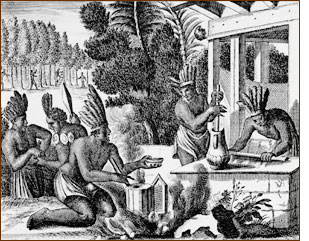
Aztecs preparing "Xocolatl": cocoa beans were roasted, ground and mixed with water
and spices to form a foamy liquid (Olfert Dapper, "Die unbekannte Neue Welt").
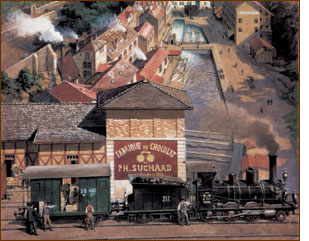
The early manufactories soon grew into real factories. The largest at the end of
the 19th century was that of Philippe Suchard in Serrières.
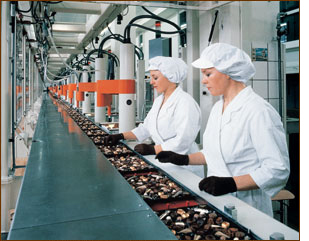
Where in the past women stood at long tables, and later conveyor belts, carefully
placing chocolates in boxes, today robots do the same job in a fraction of time.
Attentive staff check and correct the work of the robots.
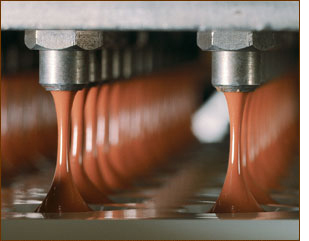
The oldest way of shaping chocolate: the fragrant liquid chocolate is measured out
into flat moulds, the shape of which represents the finished product in reverse.


